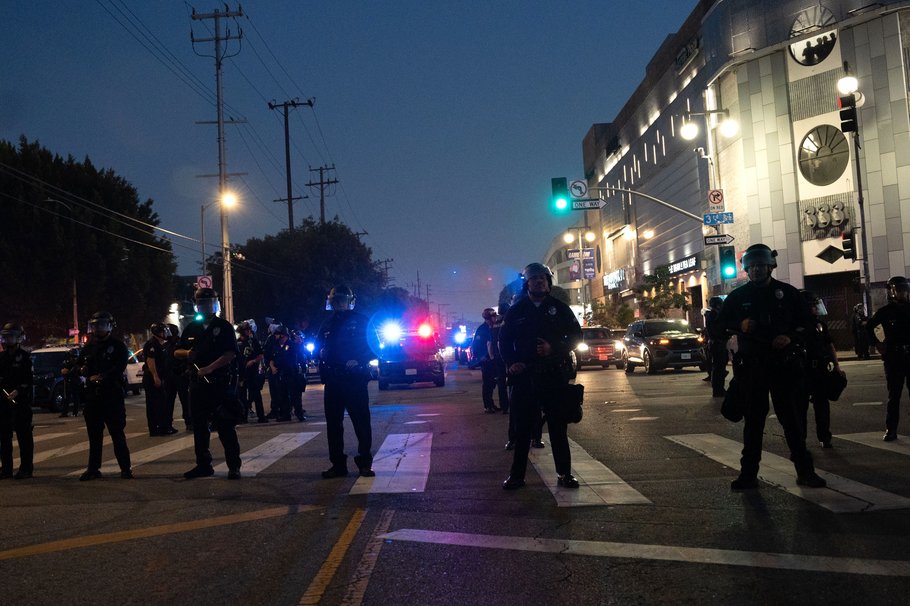Incident details
- Date of incident
- June 9, 2025
- Location
- Los Angeles, California
- Arrest status
- Detained and released without being processed
- Arresting authority
- Los Angeles Police Department
- Unnecessary use of force?
- No
Arrest/Criminal Charge
- Assailant
- Law enforcement
- Was the journalist targeted?
- Yes
Assault

Officers line up to form a kettle during an anti-deportation protest in downtown Los Angeles, California, on June 9, 2025. Student photojournalist Jake Crandall was detained while photographing inside the kettle.
Jake Crandall, a student photojournalist for Santa Monica College’s The Corsair, was detained by police while documenting an anti-deportation protest in downtown Los Angeles, California, on June 9, 2025.
Crandall was at one of a series of protests that began June 6 in response to federal raids of workplaces and areas where immigrant day laborers gathered in and around LA, amid the Trump administration’s larger immigration crackdown. After demonstrators clashed with local law enforcement officers and federal agents, President Donald Trump called in the California National Guard and then the U.S. Marines, despite objections from California Gov. Gavin Newsom and LA Mayor Karen Bass.
Crandall was on assignment for The Corsair, Santa Monica College’s student newspaper, and also working as a freelance stringer for Dori Media, an international production and distribution company, when thousands of protesters gathered near the Edward R. Roybal Federal Building in downtown Los Angeles.
As the Los Angeles Police Department moved to disperse the crowd, officers pushed demonstrators through the surrounding downtown area while firing crowd-control munitions. During the second round of fire, Crandall was struck in the lower torso by a foam-tipped projectile. He captured the impact on video, which shows the officer looking directly at him before firing.
At the time, Crandall was clearly identified as a member of the press, wearing a hat and displaying a badge and patch on his backpack. The blow, which he said felt like being hit with a paintball to the stomach, forced him to briefly stop recording.
“It knocked the wind out of me,” Crandall said. “But I was able to still continue on and finish the assignment.”
Minutes later, he was hit in the leg twice more in quick succession by similar projectiles. All three strikes left bruises.
Crandall told the U.S. Press Freedom Tracker that law enforcement continued pushing and containing the crowd for several blocks, eventually trapping a large group in a police kettle — a tactic used to surround and control protesters.
Crandall was inside the kettle, photographing fellow students being detained, when an officer pointed at him and said, “You’re next.”
Officers placed him in zip-tie restraints, searched his pockets and backpack, and positioned him against a wall. Although they didn’t go through his camera, the tone quickly shifted.
“They said, ‘We’re putting him in the paddy wagon,’” Crandall told the Tracker. “That’s when I realized I might not be getting out of there.”
After repeatedly identifying himself as a journalist, Crandall was held for about 15 minutes before a supervisor arrived, ordered his release and told him to leave the area.
“They could have grabbed anyone else,” he said. “But they chose to get me next. It was a little devious.”
In the days following his encounter with police, Crandall said he saw fellow journalists arrested, struck by crowd-control munitions and taken to the hospital. During a protest on June 6, he was pepper-sprayed and shot with a pepper ball. On June 7, he was struck by a stinger grenade, a device that releases rubber pellets and chemical irritants.
The experience has changed how Crandall works. He purchased a bullet-proof vest for assignments and keeps a legal contact on hand in case of emergencies.
“I now understand in situations like this, it’s really up to yourself to stay safe, and that it’s up to other journalists to look out for each other,” he said.
When reached for comment, the LAPD directed the U.S. Press Freedom Tracker to its social media accounts. In a June 10 statement posted to the social platform X, the department acknowledged that LAPD officers used numerous “less-lethal rounds” in response to the protests but did not address the detention of journalists or the use of munitions against identifiable press.
The U.S. Press Freedom Tracker catalogs press freedom violations in the United States. Email tips to [email protected].